1. Pure Substance
- Books Name
- Science Made Easy Science Book
- Publication
- Science Made Easy
- Course
- CBSE Class 9
- Subject
- Science
Introduction
Anything which occupies space and has mass is called matter.
Matter can be divided in two categories.
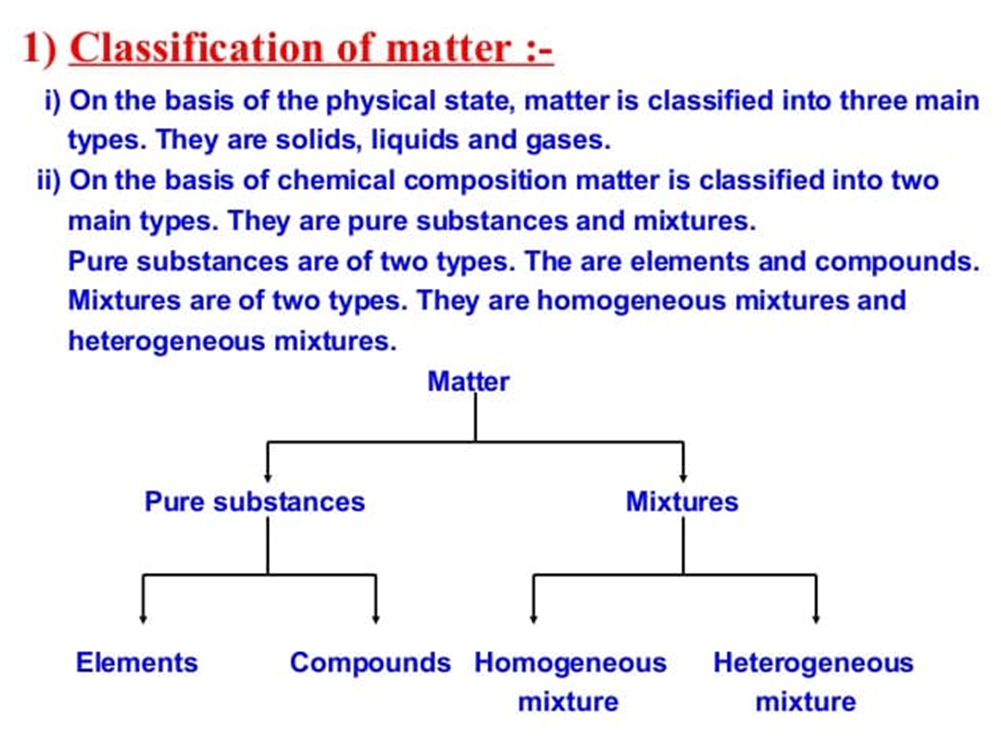
(i) Pure Substance: It consists of single types of particles which are same in their chemical nature.
(ii) Mixtures: Mixture consists of two or more particles.
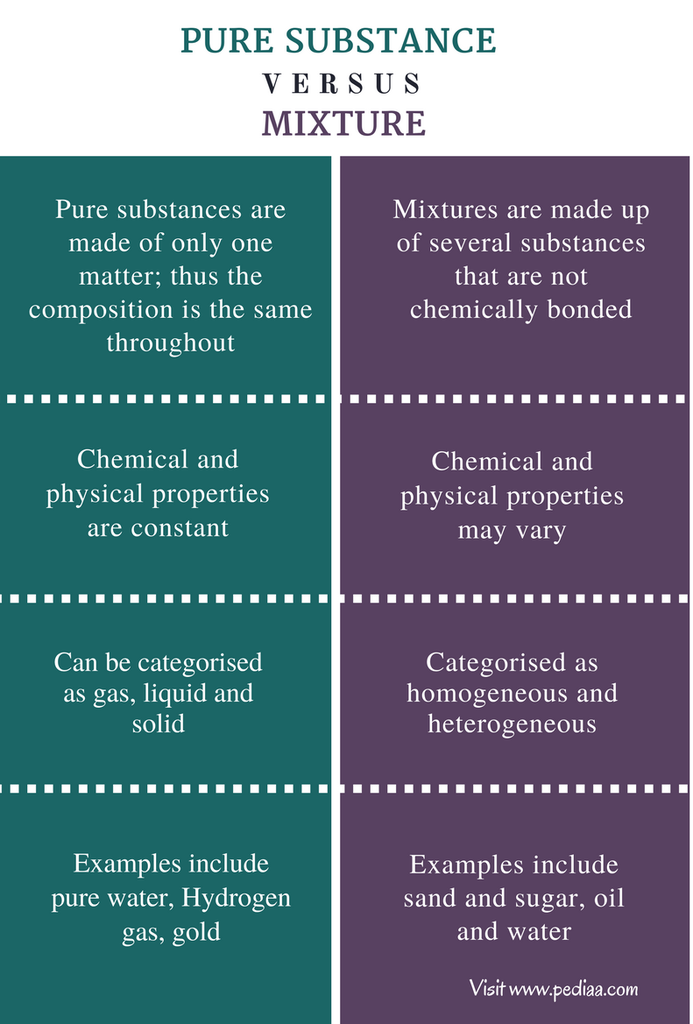
Mixture and its types
Mixture consists of more than one kind of pure substances which can be separated by physical method.
Mixtures are of two types
(i) Homogeneous mixture
(ii) Heterogeneous mixture
(i) Homogeneous mixture: A mixture is said to be homogeneous if all the components of the
mixture are uniformly mixed and there are no boundaries of separation between them.
Ex: Sugar in water, etc.
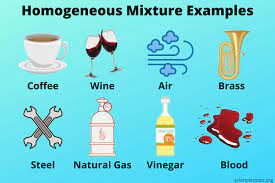
(ii) Heterogeneous mixtures: A mixture is said to be heterogeneous if all the components of the
mixture are not uniformly mixed and there are visible boundaries of separation between them
Ex: Water and sand, Air etc.
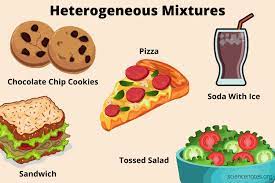
2. Impure Substance
- Books Name
- Science Made Easy Science Book
- Publication
- Science Made Easy
- Course
- CBSE Class 9
- Subject
- Science
Solution and its properties
A solution is a homogeneous mixture of two or more substances. Ex: Lemonade, soda water etc
A solution has two components:
(i) Solvent
(ii) Solute
(i) Solvent: The component of the solution that dissolves the other component in it (usually the component present in larger amount) is called the solvent.
(ii) Solute: The component of the solution that is dissolved in the solvent (usually present in less quantity) is called the solute.
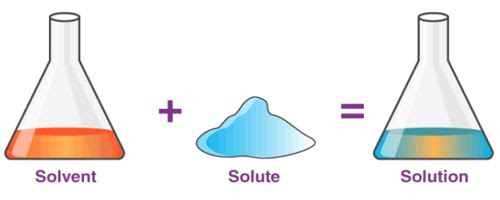
Properties of Solution:
1. A solution is a homogeneous mixture.
2. The particles of a solution are smaller than 1 nm
(10-9 ) in diameter which cannot be seen by naked
eyes.
3. They do not scatter a beam of light passing through the solution that is they don’t show tyndall effect. So, the path of light is not visible in a solution.
4. The solute particles cannot be separated from the mixture by the process of filtration.
5. The solution is stable and solute particles do not settle down when left undisturbed.
Concentration of a solution
(i) Saturated solution: When no more amount of solute can be dissolved in a solution at a give temperature, it is called a saturated solution.
(ii) Unsaturated solution: When more amount of solute can be dissolved in a solution at a give temperature, it is called a saturated solution.
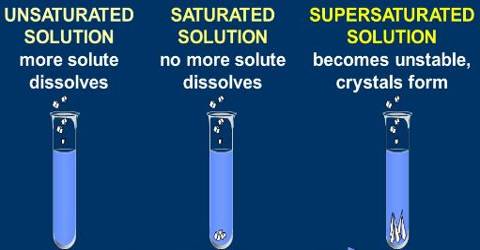
(ii) Solubility: The amount of the solute present in the saturated solution at the given temperature
called its solubility.
The concentration of a solution is the amount of solute present in a given amount (mass or volume) of solution. Also, the amount of solute dissolved in a given mass or volume of solvent is called concentration of solution.
Concentration of solution = Amount of solute/Amount of solvent or Amount of solute/Amount in
solution (Here, amount means mass or volume).
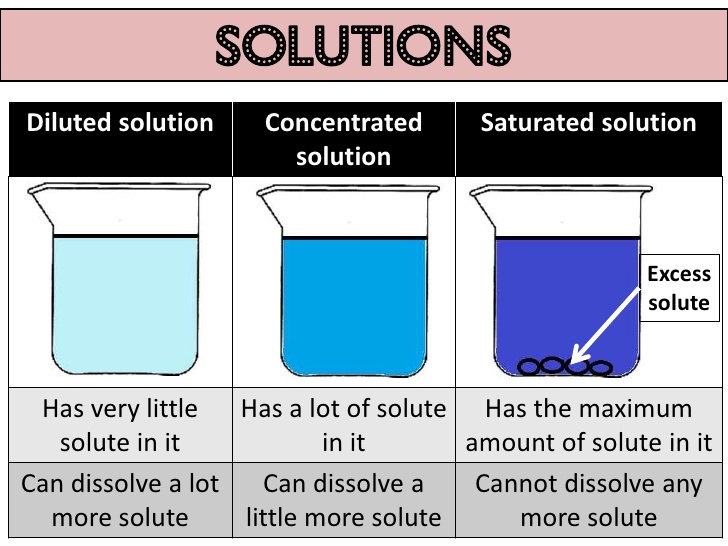
Two methods of finding concentration of solution:
(i) Mass by mass percentage of a solution = (Mass of solute/Mass of solution) ×100
(ii) Mass by volume percentage of a solution = (Mass of solute/Volume of solution) ×100
3. Separation of Mixtures
- Books Name
- Science Made Easy Science Book
- Publication
- Science Made Easy
- Course
- CBSE Class 9
- Subject
- Science
Suspension and its properties
A suspension is a heterogeneous mixture in which the the solute particles do not dissolve but
remain suspended throughout the bulk of the medium. Ex: Chalk in water, smoke in the air.
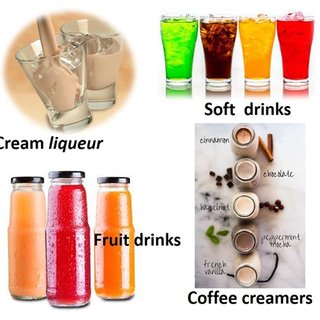
Properties of Suspension :
1. It is a heterogeneous mixture.
2. Particles of a suspension are visible to the naked eye.
3. Size of the particles is greater than 100 nm.
4. It is unstable mixture. Solute settles down at the bottom over period of time.
5. If the solution is passed through filter paper, solute and solvent gets separated.
6. It scatters light when light is passed through the solution i.e. it shows Tyndall effect.
4. Physical And Chemical Changes
- Books Name
- Science Made Easy Science Book
- Publication
- Science Made Easy
- Course
- CBSE Class 9
- Subject
- Science
Colloidal solution and its properties
Colloid solution is heterogeneous mixture in which the size of particles lies between the true solutions and suspensions.
• Colloidal particles can easily scatter a beam of visible light. This phenomenon is called
Tyndall effect.
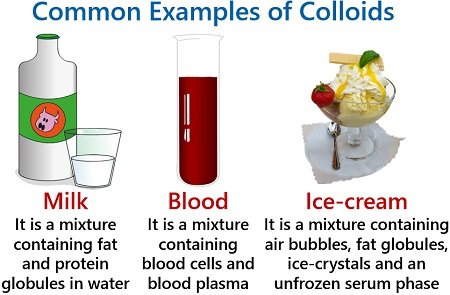
Properties of colloidal solution:
1. The particles of colloid can’t be seen by naked eyes individually.
2. It is a heterogeneous mixture and thus solute and solvent can’t be separated by filter paper.
3. Size of particles is smaller than suspensions but greater than solutions (1 nm to 100 nm).
4. It is a stable mixture. Particles do not settle down at the bottom over a period of time.
5. They do not settle down when left undisturbed which means colloid is quite stable.
Some common examples of colloids (in the table)
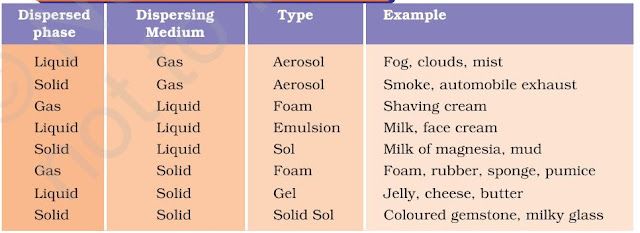
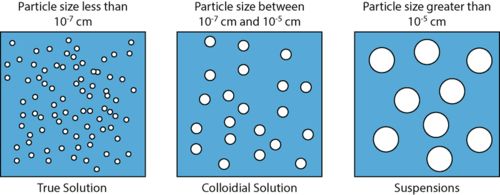

5. What Are The Types Of Pure Substances ?
- Books Name
- Science Made Easy Science Book
- Publication
- Science Made Easy
- Course
- CBSE Class 9
- Subject
- Science
Separation of the components of mixtures
Different methods of separation are used to get from mixture.
Heterogeneous mixtures can be separated into their respective constituents by simple physical
methods like handpicking, sieving, filtration etc.
Obtaining coloured components from blue/black ink
Process of evaporation is used to obtain coloured components from blue/black ink. The process of
evaporation is used to separate a substance which is dissolved in water.
• It is based on the fact that liquid vaporises easily than the solid.
• Helps in separating volatile substances from non-volatile substances.
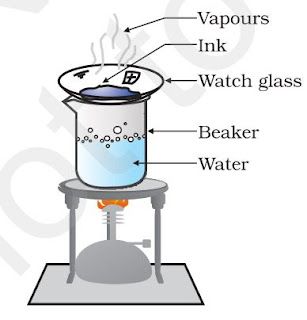
Steps of obtaining coloured components from blue/black ink:
• Fill half a beaker with water.
• Put a watch glass on the mouth of the beaker.
• Put few drops of ink on the watch glass.
• Now start heating the beaker. We do not want to heat the ink directly. You will see that evaporation
is taking place from the watch glass.
• Continue heating as the evaporation goes on and stop heating when you do not see any further
change on the watch glass.
Separation of cream from milk
• The process of centrifugation is used to separate the cream from milk. It is a method of separating
the suspended particles of substance from a liquid.
• This process is carried out by the machine called centrifuge.
• Sometimes, the solid particles in a liquid are very small and pass through a filter paper. For that
particles the filtration technique cannot be used.
• The mixture is rotated rapidly so that the heavier particles in the mixtures settle down to the
bottom.
• The basic principle of centrifugation is that the denser particles are forced to the bottom and
liquid being lighter remains at the top.
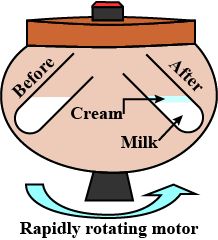
Steps of separating cream from milk:
• Take some full-cream milk in a test tube.
• Centrifuge it by using a centrifuging machine for two minutes.
Application of centrifugation:
• Used in diagnostic laboratories for blood and urine tests.
• Used in dairies and home to separate butter from cream.
• Used in washing machines to squeeze out water from wet clothes.
Separating two immiscible liquids
• The separation of separating two immiscible liquid is carried out by the use of funnel.
• The basic principle involve is the difference between the densities of two liquids form two separate layers.
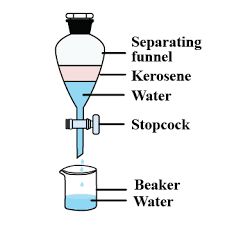
Steps of separating kerosene oil and water:
• Pour the mixture of kerosene oil and water in a separating funnel.
• Let it stand undisturbed for sometime so that separate layers of oil and water are formed.
• Open the stopcock of the separating funnel and pour out the lower layer of water carefully.
• Close the stopcock of the separating funnel as the oil reaches the stop-cock.
Application of funnel:
• To separate mixture of oil and water.
• In the extraction of iron from its ore, the lighter slag is removed from the top by this method to
leave the molten iron at the bottom in the furnace.
Sublimation
• This process is used to separate mixtures that contain a sublimable volatile component from
non-sublimable impurity.
• Sublimation is process where a substance directly changes from solid to gaseous state on heating.
• Ammonium chloride, camphor, naphthalene and anthracene are some examples which can be
sublime.
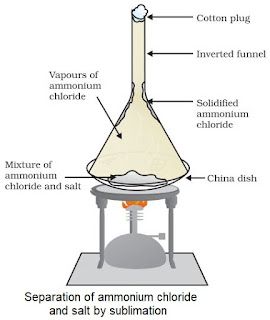
Chromatography
• Used to separate those solutes which dissolve in the same solvent.
• Used for sepration of colours.
• The colours which are more soluble in water rises faster.
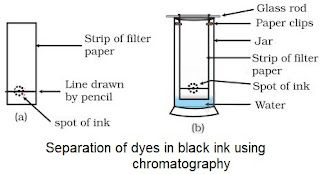
Applications
To separate
• colours in a dye
• pigments from natural colours
• drugs from blood.
Distillation
• Used for separation of components of a mixture containing two miscible liquids that boil with the
decomposition and have sufficient difference in their boiling points.
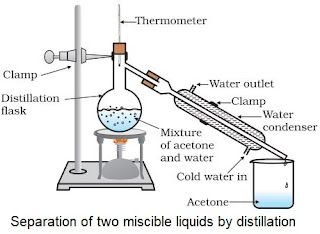
• Mixture of acetone and water is separated by this method.
Fractional distillation
• Fractional distillation is used to separate a mixture of two or more miscible liquids for which the
difference in boiling points is less than 25 K.
• Air is a homogeneous mixture and can be separated into its components by fractional distillation
Below is diagram which shows the steps of separation of air:
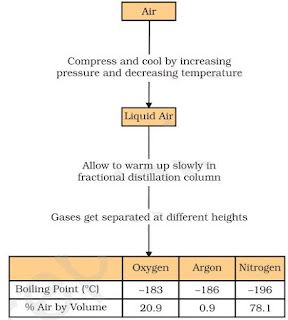
• The air is compressed by increasing the pressure and is then cooled by decreasing the temperature to get liquid air.
• The liquid air is warm-up slowly in a fractional distillation column, where gases get separated
different heights depending upon their boiling points.
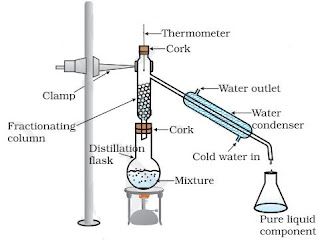
• It used to separate a gas from the air.
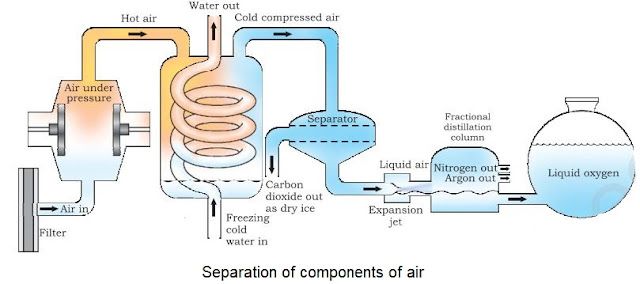
Crystallization
• Used to remove impurities from solid and purify it.
• It separates a pure solid from mixture in the form of crystals.
• This process is used in purification of salt from sea water, separation of crystals of alum from
impure samples.
• It is better method than evaporation because:
(i) Solids decompose or some, like sugar, may get charred on heating to dryness.
(ii) Some impurities may remain dissolved in the solution even after filtration. On evaporation the
contaminate the solid.

PHYSICAL & CHEMICAL CHANGES
- Books Name
- Science Made Easy Science Book
- Publication
- Science Made Easy
- Course
- CBSE Class 9
- Subject
- Science
Physical and Chemical changes
• The process which brings about changes in physical properties and no new substances are formed are physical changes. The common physical changes are changes in colour, hardness,rigidity, fluidity, density, melting point, boiling point etc.
• The process in which new Free substances are formed and chemical changed are chemical changes. Some chemical properties are odour, inflammability etc.
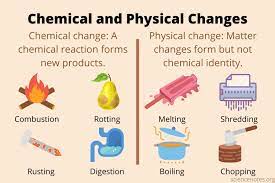
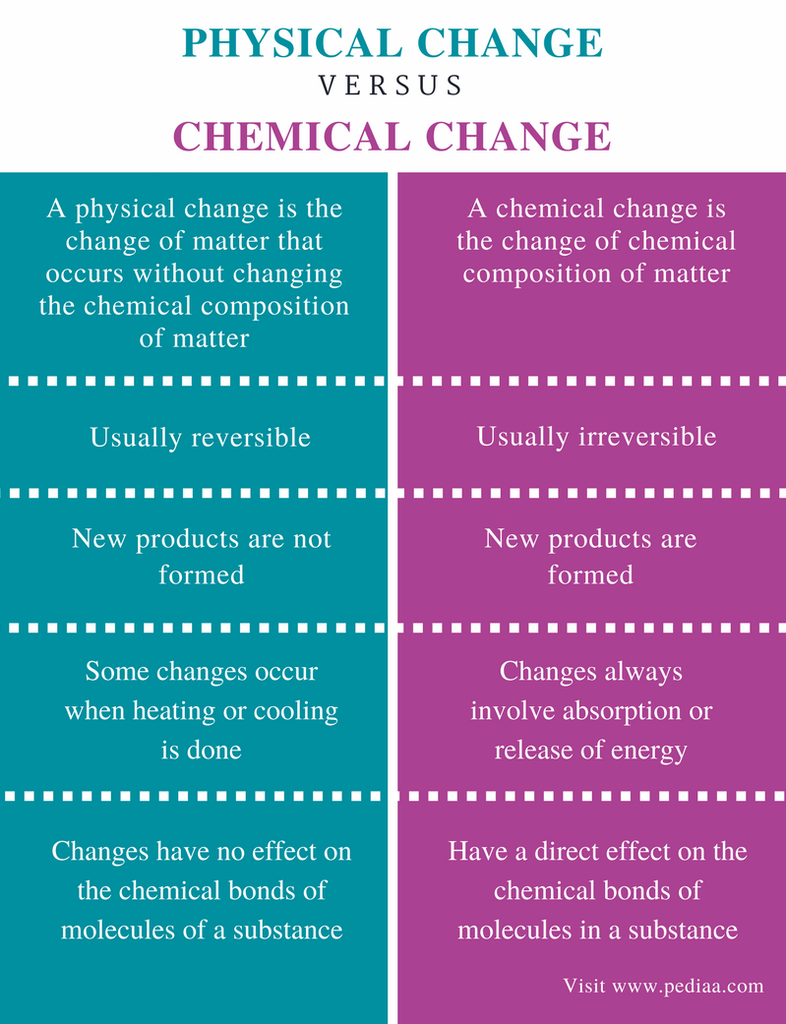
PURE SUBSTANCES AND ITS TYPES
- Books Name
- Science Made Easy Science Book
- Publication
- Science Made Easy
- Course
- CBSE Class 9
- Subject
- Science
Types of pure substances
The pure substance is divided in two types on the basis of their chemical composition:
(i) Elements
(ii) Compounds
(i) Elements
• According to Antoine Laurent Lavoisier, element is a basic form of matter that cannot be broken
down into simpler substances by chemical reactions.
• It is divided in three types which are metals, non-metals and metalloids.
Properties of Metals
(i) They have a lustre (shine).
(ii) They have silvery-grey or golden-yellow colour.
(iii) They conduct heat and electricity.
(iv) They are ductile (can be drawn into wires).
(v) They are malleable (can be hammered into thin sheets).
(vi) They are sonorous (make a ringing sound when hit).
• Examples of metals are gold, silver, copper, iron, sodium, potassium etc.
• Mercury is the only metal that is liquid at room temperature.
Properties of non-metals
(i) They display a variety of colours.
(ii) They are poor conductors of heat and electricity.
(iii) They are not lustrous, sonorous or malleable.
• Examples of non-metals are hydrogen, oxygen, iodine, carbon (coal, coke), bromine, chlorine
Metalloids: Elements having intermediate properties between those of metals and non-metal
called metalloids. Examples are boron, silicon, germanium etc.
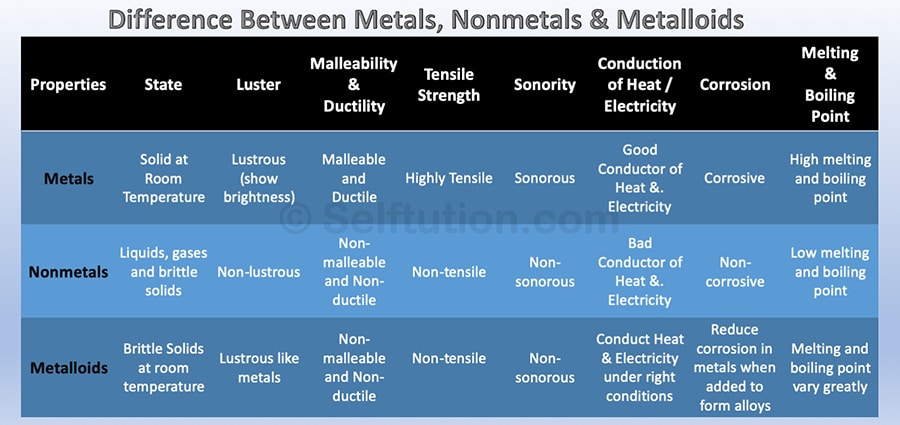
(ii) Compounds
A compound is a substance composed of two or more elements, chemically combined with oneanother in a fixed proportion.
Difference between mixtures and compounds
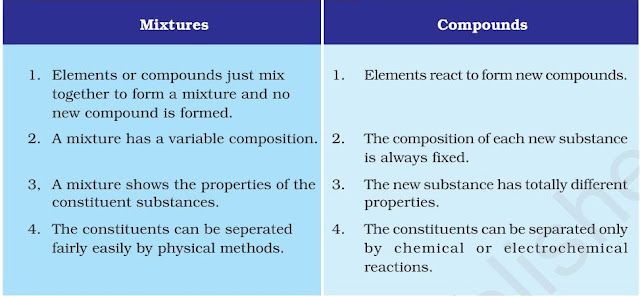

 Vaishnav Publication
Vaishnav Publication
 ACERISE INDIA
ACERISE INDIA
